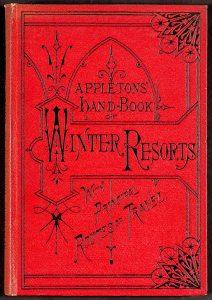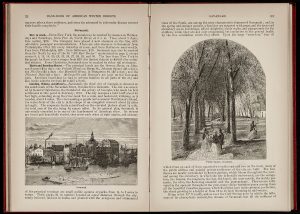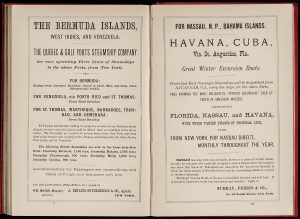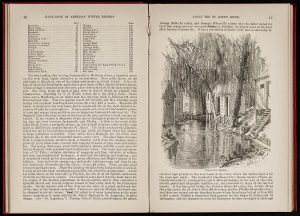by Susan Martin, Senior Processing Archivist
I don’t know about you, but just two days after the official start of winter and six days after Winter Storm Gail, I’m already dreaming of tropical climes. To whet my appetite, I turn to a fun old travel guide in the Massachusetts Historical Society’s collection, Appleton’s Illustrated Hand-book of American Winter Resorts; for Tourists and Invalids.

This small, attractive hardcover volume, only 138 pages long, is chock full of terrific illustrations and maps.

It was published in 1879 by D. Appleton and Co., a major New York publishing company run by five sons of founder Daniel Appleton. The company put out a number of targeted guidebooks like this; there’s one about summer resorts, too. In the front and back, you’ll find advertisements for hotels, banks, railroads, steamship companies, and, of course, other Appleton publications.

The book is divided into twelve sections: Florida, Georgia, South Carolina, North Carolina, Minnesota, Arkansas Hot Springs, Colorado, California, the Lower Mississippi, the West Indies, the Bermudas, and the Sandwich Islands. Sections include general descriptions; descriptions of major cities, towns, rivers, etc.; lists of hotels and boarding houses; and information on climate, history, and points of interest.
As you can tell from its unfortunate title, this book is targeted not only at recreational travelers, but also “invalids,” primarily tuberculosis patients, or “consumptives” in the vernacular of the time. Included are “all the facts as to climatic and local conditions” in each location, as well as testimonials by physicians and even mortality rates!
The largest section by far is the one on Florida, a popular destination for “those afflicted with pulmonary complaints.” The anonymous author waxes almost poetic about the state’s many rivers, including the St. Johns and the Ocklawaha. My favorite illustration, depicting Green Cove Springs, also appears in this section.

The guidebook contains some fascinating factoids that give us a snapshot of what vacations were like in 1879. Travel by train cost 2-3 cents per mile (more in the southern and western United States); steamboats were even cheaper; the going rate for first-class hotels was $4.00-$4.50 per day; and only gold and silver, not U.S. Treasury notes or National Bank bills, were legal tender in California. A train ticket from New York to San Francisco would run you $138.
Speaking of California, I particularly enjoyed the description of a quaint little town called Los Angeles.
Its present population is about 12,000, and the adobe buildings, of which it was originally composed, are fast giving way to larger and more imposing structures. It has a large and varied trade with the interior, and contains three banks, a Roman Catholic college, several public schools, a public library, three daily and two weekly newspapers, churches of the various denominations, and good hotels.
What other tips did the Appletons have for the resourceful tourist or “consumptive” in search of relief?
Our American climate is very changeable, and the traveler had better suffer at noonday from too much clothing than expose himself at night, in storms, or to sudden changes of temperature, with too little. One should wear woolen underclothing, both summer and winter, and always have a shawl or extra wrapper of some kind at hand.
Here’s hoping you are enjoying whatever weather you happen to be in!


Thank you for this delightful gift. The industry that catered to consumptives is all but forgotten today. We are thankful that the disease is no longer a scourge, but the industry that catered to moneyed invalids should not be forgotten.